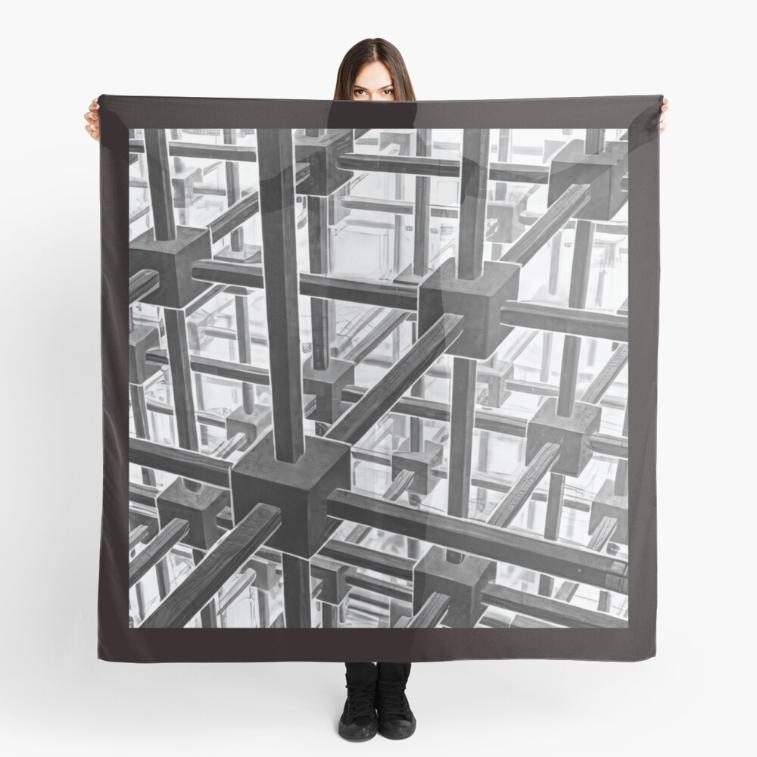- 1 Escher Struggled in School
- 2 Escher was Influenced by Family
- 3 Escher had Architectural Aspirations
- 4 Escher was Fascinated with Moorish Art
- 5 Escher Connected with Scientists
- 6 Escher Explored Naturalistic Art
- 7 Escher was Influenced by Italy
- 8 Escher was Self-Taught in Printmaking
- 9 Escher was More Than an Artist
- 10 Escher Created During Wartime
- 11 Escher was Rejected by the Art World
- 12 Escher Designed for Currency
- 13 Escher had Persistent Health Issues
- 14 Escher was Influenced by Travel
- 15 Escher Experimented with Techniques
- 16 Escher used Art for Self-Reflection
- 17 Escher Preferred Sketching at Night
- 18 Escher Struggled with Social Anxiety
- 19 Escher has Become a Popular Culture Icon
- Escher’s Legacy of Perception and Imagination
- FAQs about M.C. Escher and His Art
- Sources

You have probably stood before some of M.C. Escher’s mind-bending artwork, marveling at his creations. Just like countless others have.
His impossible structures have fascinated art lovers and casual observers. From endless staircases to interlocking patterns, Escher’s work challenges our perceptions and invites you into a world where the boundaries of reality blur.
What you may not know is that behind these famous artworks lies a wealth of lesser-known facts about Escher’s life.
This article delves into 20 fascinating insights that reveal the man behind the mesmerizing art. You’ll discover surprising details about his inspirations, techniques, and personal experiences that shaped his unique perspective.

1 Escher Struggled in School
M.C. Escher’s early years were marked by many challenges. He was frequently ill and had trouble in school, even failing the second grade.
Despite his obvious talent for drawingDrawing is a foundational art form that involves creating images on a surface, typically paper, using tools such as pencils, pens, and charcoal. It is a versatile medium that allows artists to express ideas, emotions, and stories through lines, shapes, and shading. Historical Background • Prehistoric Beginnings: The earliest known drawings date back to prehistoric times, with cave drawings found More, his academic performance was poor. Known as “Mauk” to his loved ones, Escher needed special education from an early age due to his health issues.
These struggles, however, did not stop him from pursuing art. His family saw his talent and supported his creative pursuits. Escher’s early difficulties highlight the resilience and determination that later defined his career (Illustration History 2024; 1stDibs 2024; Brown University 2024; Verovine).

2 Escher was Influenced by Family
M.C. Escher’s father was a civil engineer, which greatly impacted Escher’s artistic development. Growing up in a family that valued precision and design, Escher developed a keen eye for detail and a fascination with structures. Watching his father work, he absorbed principles of engineering and architecture, which influenced his intricate art.
Escher’s exposure to his father’s projects taught him the importance of structure and detail, shaping his unique artistic vision. His works often feature complex, interconnected forms, reflecting his early exposure to engineering concepts. This blend of creativity and technical skill sets Escher apart as an artist (National Gallery of Art, n.d.; Escher, n.d.; Hyperallergic, 2020; Illustration History, 2024).
3 Escher had Architectural Aspirations
You might be surprised to read that M.C. Escher initially set out to become an architect and enrolled in the School for Architecture in Haarlem. His early experiences there shaped his approach to art, teaching him precision and structural elements.
However, under the mentorship of graphic artist Samuel Jessurun de Mesquita, Escher discovered his passion for the graphic arts. This new direction wasn’t immediate, but gradually, Escher fully embraced it.
His architectural training still influenced his later works, visible in his detailed designs and impossible structures. The change shows his flexibility and willingness to follow his passion, combining artistic expression with physical structure (The Museum of Modern Art, n.d.; The My Hero Project, n.d.; Artnet, n.d.; Core, 2014; Western Oregon University, n.d.; Lampe-Soutberg, 1968).


4 Escher was Fascinated with Moorish Art
M.C. Escher’s designs were deeply influenced by Moorish architecture. During his travels in Spain, Escher visited the Alhambra in Granada, a 14th-century palace known for its beautiful tile work and geometric patterns. These designs, characteristic of Moorish art, fascinated Escher, and he spent time studying and sketchingSketching is a fundamental practice in the art world, involving the creation of quick, loose drawings to capture basic shapes, forms, and ideas. It serves as the backbone for more detailed artworks and helps artists refine their concepts. Essential Sketching Supplies • Pencils: Ranging from hard (H) to soft (B) grades, providing a variety of lines and textures. • Paper: More them.
This exposure had a strong impact on his art, especially his work with tessellationsDefinition and Overview A tessellation is a pattern of shapes that fit perfectly together without any gaps or overlaps. These patterns can extend infinitely in any direction on a flat plane. Tessellations are often seen in art, architecture, and nature, and they play a significant role in the field of mathematics, particularly in geometry. Types of Tessellations There are three More. The precise, repetitive patterns he saw at the Alhambra became a key feature of his own creations.
His art often includes interlocking shapes and impossible constructions that reflect the geometric harmony he admired in Moorish designs. This influence is evident in many of his famous pieces, blending creativity with mathematical concepts to create captivating and thought-provoking art (1stDibs, 2024; Brown University, 2024; Verovine, n.d.; The Art Story, n.d.; BBC, 2015).

5 Escher Connected with Scientists
M.C. Escher’s art has gained great admiration from scientists and mathematicians. His pieces, like “Relativity” and “Ascending and Descending,” are both visually stunning and rich with mathematical ideas. Escher’s patterns and use of symmetry create mind-bending illusions that illustrate complex mathematical concepts.
You can see how his work makes these concepts more accessible and engaging. Escher’s ability to blend art with mathematics has led to his work being featured in scientific papers and discussions. This fusion of math and art demonstrates the depth of his works and appeals to both science and art enthusiasts (Britannica, n.d.; Escher in the Palace, n.d.; National Gallery of Art, n.d.; Escher, n.d.; Hyperallergic, 2020).

6 Escher Explored Naturalistic Art
Before M.C. Escher became known for his optical illusions, he focused on creating naturalistic illustrations of landscapes and architecture. During his early career, Escher captured the beauty of the countryside and medieval buildings with great precision. Imagine him sketchingSketching is a fundamental practice in the art world, involving the creation of quick, loose drawings to capture basic shapes, forms, and ideas. It serves as the backbone for more detailed artworks and helps artists refine their concepts. Essential Sketching Supplies • Pencils: Ranging from hard (H) to soft (B) grades, providing a variety of lines and textures. • Paper: More these scenes with a keen eye for detail, bringing them to life on paper.
These early works show a different side of Escher’s talent, emphasizing his versatility as an artist. His skill in drawingDrawing is a foundational art form that involves creating images on a surface, typically paper, using tools such as pencils, pens, and charcoal. It is a versatile medium that allows artists to express ideas, emotions, and stories through lines, shapes, and shading. Historical Background • Prehistoric Beginnings: The earliest known drawings date back to prehistoric times, with cave drawings found More realistic scenes prepared the way for his later studies of geometric patterns and impossible structures. It was the springboard for developing his unique style, blending realismRealism is an art movement that emerged in the mid-19th century, emphasizing the depiction of subjects as they appear in everyday life. It rejects the idealized forms and dramatic expressions of Romanticism, focusing instead on accuracy, truthfulness, and the mundane aspects of the human experience. Realism strives to capture the world in a straightforward and unembellished manner. Gustave Courbet, The More with the surreal elements that made him famous (The Guardian, 2015; The Museum of Modern Art, n.d.; The My Hero Project, n.d.; Artnet, n.d.; Core, 2014; Western Oregon University, n.d.; Lampe-Soutberg, 1968; Escher in Het Paleis, n.d.).

7 Escher was Influenced by Italy
M.C. Escher spent over a decade in Italy, where the landscapes and architecture had a strong influence on his work. He found inspiration in the countryside and old buildings, which he sketched during his stay. These sketches became the basis for many of his famous works, such as “Waterfall.”
Escher’s time in Italy allowed him to blend natural beauty with surreal elements in his art. Places like Abruzzi and the Amalfi Coast often appear in his pieces, showcasing his ability to turn everyday scenes into visual paradoxes. This period was key to shaping his unique style, where realistic and fantastical elements coexist seamlessly (1stDibs, 2024; Brown University, 2024; Verovine, n.d.; The Art Story, n.d.; BBC, 2015; Learnodo Newtonic, 2020; Escher: The Exhibition & Experience, n.d.; The Met, n.d.; Museum of Fine Arts, Houston, 2021; National Gallery of Victoria, 2018; The Guardian, 2015; The Museum of Modern Art, n.d.).

8 Escher was Self-Taught in Printmaking
Did you know that M.C. Escher taught himself the art of printmaking? Instead of formal training, he explored techniques like lithography and woodcuts on his own. This hands-on approach allowed him to combine technical skill with creative imagination.
His early experiments laid the groundwork for his unique style. You can see the detailed designs and innovative perspectives in his work. Escher’s journey in printmaking shows how his self-driven learning led to a body of work that’s both original and captivating (Britannica, n.d.; M.C. Escher Collection, n.d.; Escher in Het Paleis, 2018; McKinney et al., 2015; Bosdriesz, 1999; Escher in Het Paleis, 2019; Escher in Het Paleis, 2019).

9 Escher was More Than an Artist
You might be surprised to learn that M.C. Escher’s talents extended beyond his famous prints. He illustrated books, designed carpets, and even created sketches for Dutch currency, every time showcasing his unique aesthetic.
Escher’s book illustrations brought stories to life with his personal style. His carpet designs transformed functional items into art with repetitive patterns and geometric precision. Even his currency sketches displayed his keen eye for detail, turning everyday items into visual masterpieces. These lesser-known works highlight his adaptability and creativity across different fields. (The Art Story, n.d.; BBC, 2015; Learnodo Newtonic, 2020; Escher: The Exhibition & Experience, n.d.; The Met, n.d.; Museum of Fine Arts, Houston, 2021; National Gallery of Victoria, 2018).

10 Escher Created During Wartime
During World War II, M.C. Escher found comfort and focus in his art, creating many of his symmetrical drawings. These works, made during a time of conflict, later became key parts of his legacy.
Picture Escher channeling his energy into perfecting these designs, known for their precise patterns and geometric detail. This period shaped the iconic style associated with his name. His wartime productivity shows his resilience and dedication, resulting in some of his most enduring works ( McKinney et al., 2015; Bosdriesz, 1999; Escher in Het Paleis, 2019; Escher in Het Paleis, 2019; Escher in Het Paleis, 2017; Escher in Het Paleis, 2019).

11 Escher was Rejected by the Art World
For much of his life, M.C. Escher’s work was not fully appreciated by the mainstream art world. Despite his brilliant designs, the art establishment often overlooked his unique style and vision. It wasn’t until later in his career that Escher began to receive the recognition he deserved.
Imagine the frustration Escher must have felt, as his designs and mathematical precision were ahead of their time. While scientists and mathematicians admired his work, traditional art critics were slow to embrace his innovative approach. This shows how challenging it can be for groundbreaking artists to gain acceptance (Britannica, n.d.; Escher in the Palace, n.d.;Verovine, n.d.; The Art Story, n.d.; BBC, 2015; Learnodo Newtonic, 2020; Escher: The Exhibition & Experience, n.d.; The Met, n.d.; Museum of Fine Arts, Houston, 2021).

12 Escher Designed for Currency
In 1950, M.C. Escher submitted designs for Dutch banknotes featuring his geometric patterns. However, they were never used. Imagine holding a banknote with Escher’s unique designs, blending art with mathematical precision.
These illustrations reflected his unique style and showcased his versatility in applying his artistic vision to practical items. Although the banknotes didn’t enter circulation, this attempt highlights another facet of Escher’s eagerness to explore new mediums (Museum of Fine Arts, Houston, 2021; National Gallery of Victoria, 2018; The Guardian, 2015; The Museum of Modern Art, n.d.).

13 Escher had Persistent Health Issues
M.C. Escher dealt with ongoing health issues all of his life. As a child, he struggled with a recurring skin infection that affected his studies and required special schooling. Later, in 1962, he had surgery to remove a cancerous tumor from his liver. Despite these difficulties, Escher remained committed to his art, producing his captivating works. His ability to continue creating under such conditions speaks to his resilience and passion (National Gallery of Art, n.d.; Escher, n.d.; Hyperallergic, 2020; Illustration History, 2024; 1stDibs, 2024; Brown University, 2024; Verovine, n.d.; The Art Story, n.d.; BBC, 2015; Learnodo Newtonic, 2020; Escher; The Met, n.d.; McKinney et al., 2015; Bosdriesz, 1999).

14 Escher was Influenced by Travel
Traveling through Italy and Spain had a significant influence on M.C. Escher’s artistic output. He often sketched the landscapes and historic architecture he saw. These sketches later became the basis for many of his famous works such as “Metamorphosis” and “Waterfall.”
Imagine Escher wandering through the Italian countryside and admiring the famous designs of Moorish architecture in Spain. His experiences during these trips added rich detail to his art, blending the beauty of these places with his geometric precision. His travels clearly had an impact on how he captured the spirit of these locations, turning them into surreal yet recognizable elements in his artwork (Bosdriesz, 1999; Escher in Het Paleis, 2019; Escher in Het Paleis, 2019; Escher in Het Paleis, 2017; Escher in Het Paleis, 2019).

15 Escher Experimented with Techniques
M.C. Escher experimented with various printmaking techniques, starting with woodcuts. He created sharp contrasts and interlocking patterns using knives and chisels to carve into wood blocks. Early in his career, he also used linoleum cuts with similar methods.
Escher began making lithographs in 1929, a process where he drew on stone slabs with an oily medium. He also developed “scratch drawings,” where he scratched into ink-coated paper, leading to his lithography work. Throughout his career, Escher’s experiments with different techniques helped him explore visual illusions and mirrored reflections (National Gallery of Art, n.d.; Escher, n.d.; Hyperallergic, 2020; Illustration History, 2024).

16 Escher used Art for Self-Reflection
M.C. Escher used his art to explore perspective and self-reflection, notably in his famous self-portrait “Hand with Reflecting Sphere.” This piece shows Escher looking into a reflective sphere, capturing his image and the surrounding room in one distorted reflection.
The reflective sphere not only serves as a mirror but also distorts reality, bending it in a way that challenges the viewer’s perception. The work is a brilliant example of how Escher played with perspective, creating a scene that is both familiar and otherworldly. By placing himself within the reflection, Escher also invites the audience to think about the nature of self-perception and reality (Britannica, n.d.; McKinney et al., 2015; Bosdriesz, 1999; Escher in Het Paleis, 2019).

17 Escher Preferred Sketching at Night
M.C. Escher often sketched cityscapes at night, capturing the unique atmosphere and transforming them into his intriguing prints. The play of shadows and light added mystery and depth to his work, bringing the quiet beauty of nighttime scenes to life. Furthermore, the tranquility and solitude of night allowed him to observe the details of architecture and urban landscapes differently.
These nocturnal sketches provided raw material for some of his most famous works, highlighting his ability to see the extraordinary in the ordinary. By turning these melancholic, nocturnal moments into intricate compositions, Escher showed his ability to combine fantasy and reality (M.C. Escher Collection, n.d.; Escher in Het Paleis, 2018; McKinney et al., 2015; Bosdriesz, 1999; Escher in Het Paleis, 2017; Escher in Het Paleis, 2019).

18 Escher Struggled with Social Anxiety
M.C. Escher struggled with social anxiety throughout his life, which influenced his art. He often avoided socializing and found it too stressful to have someone sit for him as a model. Most of his portraits are self-portraits observed through a mirror or intimate depictions of close family members like his father, wife, and sons. These personal artworks were rarely for sale, reflecting his emotional attachment and preference for privacy.
This shyness and attention to detail added a unique stiffness and formality to his figures, showcasing his technical skill and emotional depth (Britannica, n.d.; Escher in the Palace, n.d.; National Gallery of Art, n.d.; Escher, n.d.; Hyperallergic, 2020; Illustration History, 2024; 1stDibs, 2024; Brown University, 2024; Verovine, n.d.; The Art Story, n.d.).

19 Escher has Become a Popular Culture Icon
M.C. Escher’s work has profoundly influenced pop culture, particularly film, music, and fashion. In the film “Labyrinth” (1986), the climactic scene with its gravity-defying staircases was directly inspired by Escher’s “Relativity.” Christopher Nolan’s “Inception” (2010) also drew heavily from Escher’s work, with the Penrose Stairs sequence mirroring “Ascending and Descending.”
In music, the 1969 album cover of Mott the Hoople’s self-titled debut referenced Escher’s lithograph “Reptiles.” Mike Oldfield’s 1976 album “Boxed” featured references to Escher’s “Print Gallery” and “Another World II,” while Daft Punk’s music video for “Around the World” showcased people dressed like mummies, similar to those in Escher’s works, walking on a set of stairs.
Escher’s influence extends to fashion and design as well. In 2017, the streetwear brand Supreme released a collection featuring Escher’s iconic prints on shirts, hoodies, and jackets. And the architectural firm Studio 10 designed an M.C. Escher-inspired guesthouse with illusionary spaces and endless staircases, bringing his visual illusions into the interior design sphere ( National Gallery of Art, n.d.; Escher, n.d.; Hyperallergic, 2020; Illustration History, 2024;Brown University, 2024; Verovine, n.d.; The Art Story, n.d.; BBC, 2015).

Escher’s Legacy of Perception and Imagination
M.C. Escher’s work continues to captivate and inspire, demonstrating his lasting influence on both art and mathematics. His legacy is celebrated through numerous exhibitions worldwide, showcasing the enduring fascination with his unique vision. Notable exhibitions include “Escher: The Exhibition and Experience,” which toured globally, and “M.C. Escher: Infinite Dimensions” at the Museum of Fine Arts, Houston. Additionally, “Escher x nendo | Between Two Worlds” at the National Gallery of Victoria highlighted the timeless relevance of his art.
These exhibitions draw large crowds, attesting to the universal appeal of Escher’s intricate designs and innovative techniques. They provide a platform for new generations to explore his work, ensuring that his legacy remains vibrant and influential.
There is still much more to discover about Escher beyond the 20 intriguing facts we’ve covered. His art invites endless exploration and interpretation, offering new insights with each viewing. As exhibitions continue to bring Escher’s work to audiences worldwide, his ability to blend art with complex mathematical ideas ensures that his creations will remain relevant and inspiring for years to come.

FAQs about M.C. Escher and His Art
Q: What is M.C. Escher’s “Another World” about?
A: “Another World” is a lithograph created by M.C. Escher in 1947. It features an architectural structure with three distinct gravity-defying perspectives. This piece is renowned for its impossible architecture and mind-bending visual paradoxes, which invite viewers to question their perceptions of reality. Escher’s meticulous attention to detail and his ability to merge different viewpoints into one cohesive image make this artwork a fascinating study in optical illusion.
Q: Can you describe M.C. Escher’s “3 Worlds”?
A: “Three Worlds” is a mezzotint created by Escher in 1955. It depicts a pond reflecting a forest, showing three distinct planes: the water surface, the underwater scene, and the reflection of the trees above. This artwork exemplifies Escher’s fascination with different perspectives and layers of reality. The intricate details and the seamless blending of these three worlds create a visually compelling piece.
Q: What is significant about M.C. Escher’s “Butterflies”?
A: “Butterflies” is one of Escher’s notable tessellationsDefinition and Overview A tessellation is a pattern of shapes that fit perfectly together without any gaps or overlaps. These patterns can extend infinitely in any direction on a flat plane. Tessellations are often seen in art, architecture, and nature, and they play a significant role in the field of mathematics, particularly in geometry. Types of Tessellations There are three More, where he explores the concept of symmetry and transformation. The artwork features a series of butterflies that gradually change shape and form, demonstrating his skill in creating continuous patterns. This piece showcases Escher’s interest in natural forms and mathematical precision. It remains a popular example of his ability to blend art with geometric concepts.
Q: What are some famous M.C. Escher quotes?
A: One of M.C. Escher’s most famous quotes is, “Only those who attempt the absurd will achieve the impossible.” This reflects his approach to creating art that challenges conventional perspectives. Another notable quote is, “My work is a game, a very serious game.” These words capture the playful yet meticulous nature of his artistic process. Escher’s quotes offer insight into his mindset and creative philosophy.
Q: What is the “M.C. Escher: Journey to Infinity” documentary about?
A: “M.C. Escher: Journey to Infinity” is a documentary that explores the life and work of M.C. Escher. It delves into his artistic journey, from his early influences to his most famous works. The documentary features interviews, animations of his drawings, and Escher’s own words narrated by actor Stephen Fry. It provides a comprehensive look at the mind of one of the most intriguing artists of the 20th century.
Q: Where can I find examples of M.C. Escher’s work?
A: Examples of Escher’s work can be found in various art museums and online galleries. Notable pieces include “Relativity,” “Ascending and Descending,” and “Hand with Reflecting Sphere.” His work is also featured in exhibitions such as “Escher: The Exhibition and Experience.” These examples showcase his unique approach to art, blending mathematical concepts with visual art.
Q: What are some notable Escher paintings?
A: While Escher is primarily known for his prints, he did create notable works that could be considered paintings. “Metamorphosis III” and “Day and Night” are prime examples of his ability to merge visual storytelling with artistic innovation. These pieces highlight his use of geometric transformations and intricate patterns. Escher’s paintings, like his prints, challenge viewers to reconsider their understanding of space and reality.
Q: What is “stair art” in relation to M.C. Escher?
A: “Stair art” refers to Escher’s famous depictions of impossible staircases, most notably seen in his lithograph “Relativity.” In this work, multiple staircases intersect and defy traditional perspectives of gravity. These stairs create an endless loop, challenging viewers to make sense of the spatial paradoxes. Escher’s stair art is a hallmark of his ability to blend architectural precision with optical illusion.
Q: How has Escher influenced street artStreet art transforms public spaces into dynamic canvases, blending creativity with social commentary. From graffiti to murals, this art form engages with urban environments, reflecting the pulse of the community and often challenging societal norms. Street art has evolved from its rebellious roots into a respected and influential form of artistic expression. Origins and Evolution Street art's origins lie in More?
A: Escher’s influence extends to street artStreet art transforms public spaces into dynamic canvases, blending creativity with social commentary. From graffiti to murals, this art form engages with urban environments, reflecting the pulse of the community and often challenging societal norms. Street art has evolved from its rebellious roots into a respected and influential form of artistic expression. Origins and Evolution Street art's origins lie in More, where artists incorporate his themes of optical illusion and impossible structures. Murals and installations often pay homage to Escher’s unique style, recreating his complex patterns on a larger scale. This influence underscores the timeless and universal appeal of his work. Street artists draw inspiration from Escher’s ability to manipulate perspective and space.
Q: What are some key characteristics of Escher drawings?
A: Escher’s drawings are characterized by their precise line work, intricate patterns, and use of mathematical concepts. He often explored themes of infinity, symmetry, and impossible constructions. His ability to blend meticulous detail with imaginative scenes sets his drawings apart. Examples include “DrawingDrawing is a foundational art form that involves creating images on a surface, typically paper, using tools such as pencils, pens, and charcoal. It is a versatile medium that allows artists to express ideas, emotions, and stories through lines, shapes, and shading. Historical Background • Prehistoric Beginnings: The earliest known drawings date back to prehistoric times, with cave drawings found More Hands” and “Reptiles,” both showcasing his technical skill and creative vision.
Q: What makes M.C. Escher’s art work unique?
A: Escher’s art is unique due to its blend of mathematical precision and imaginative design. His works often feature impossible constructions, infinite loops, and intricate tessellationsDefinition and Overview A tessellation is a pattern of shapes that fit perfectly together without any gaps or overlaps. These patterns can extend infinitely in any direction on a flat plane. Tessellations are often seen in art, architecture, and nature, and they play a significant role in the field of mathematics, particularly in geometry. Types of Tessellations There are three More. This combination challenges viewers’ perceptions and invites them to explore new dimensions of reality. His meticulous technique and innovative approach have made his art timeless and universally admired.
Q: How can M.C. Escher’s art be enjoyed by kids?
A: M.C. Escher’s art can captivate kids with its playful and visually engaging designs. Books and interactive exhibits often feature his work, making it accessible and fun for younger audiences. Educational activities, such as creating simple tessellationsDefinition and Overview A tessellation is a pattern of shapes that fit perfectly together without any gaps or overlaps. These patterns can extend infinitely in any direction on a flat plane. Tessellations are often seen in art, architecture, and nature, and they play a significant role in the field of mathematics, particularly in geometry. Types of Tessellations There are three More, can introduce children to Escher’s concepts. His art stimulates curiosity and imagination, making it a great tool for learning.
Q: What are some examples of M.C. Escher’s tessellationsDefinition and Overview A tessellation is a pattern of shapes that fit perfectly together without any gaps or overlaps. These patterns can extend infinitely in any direction on a flat plane. Tessellations are often seen in art, architecture, and nature, and they play a significant role in the field of mathematics, particularly in geometry. Types of Tessellations There are three More?
A: Examples of Escher’s tessellationsDefinition and Overview A tessellation is a pattern of shapes that fit perfectly together without any gaps or overlaps. These patterns can extend infinitely in any direction on a flat plane. Tessellations are often seen in art, architecture, and nature, and they play a significant role in the field of mathematics, particularly in geometry. Types of Tessellations There are three More include “Reptiles,” “Sky and Water I,” and “Lizard.” These works feature interlocking shapes that seamlessly repeat across the plane. Escher’s tessellationsDefinition and Overview A tessellation is a pattern of shapes that fit perfectly together without any gaps or overlaps. These patterns can extend infinitely in any direction on a flat plane. Tessellations are often seen in art, architecture, and nature, and they play a significant role in the field of mathematics, particularly in geometry. Types of Tessellations There are three More are renowned for their mathematical precision and creative use of space. These pieces exemplify his fascination with symmetry and transformation.
Q: What is the significance of M.C. Escher’s “Relativity”?
A: “Relativity” is one of Escher’s most famous works, depicting a world where the laws of gravity do not apply. The lithograph features multiple staircases that intersect in impossible ways, with figures navigating them in different orientations. This piece challenges viewers to reconsider their understanding of space and perspective. “Relativity” is a prime example of Escher’s ability to blend art with complex spatial concepts.
Q: How has Escher inspired modern artists?
A: Escher has inspired modern artists by demonstrating how mathematical concepts can be incorporated into art. His use of perspective, symmetry, and tessellation has influenced various artistic disciplines, from graphic design to architecture. Contemporary artists often reference Escher’s techniques and themes in their own work. His legacy continues to inspire creativity and innovation in the art world.
Q: What makes Escher’s optical illusions so compelling?
A: Escher’s optical illusions are compelling due to their ability to play with viewers’ perceptions of reality. Works like “Ascending and Descending” and “Waterfall” create impossible scenarios that challenge the mind. His precise technique and imaginative compositions draw viewers into a world where the impossible seems possible. These illusions highlight Escher’s mastery of visual trickery and mathematical concepts.
Q: What are some easy Escher-inspired art projects for kids?
A: Easy Escher-inspired art projects for kids include creating tessellation patterns using simple shapes like squares or triangles. Another fun activity is drawingDrawing is a foundational art form that involves creating images on a surface, typically paper, using tools such as pencils, pens, and charcoal. It is a versatile medium that allows artists to express ideas, emotions, and stories through lines, shapes, and shading. Historical Background • Prehistoric Beginnings: The earliest known drawings date back to prehistoric times, with cave drawings found More optical illusions, such as endless staircases or interlocking shapes. These projects introduce children to Escher’s techniques in a hands-on, engaging way. They provide a foundation for understanding the principles behind his famous works.
Q: What are some famous Escher tessellationsDefinition and Overview A tessellation is a pattern of shapes that fit perfectly together without any gaps or overlaps. These patterns can extend infinitely in any direction on a flat plane. Tessellations are often seen in art, architecture, and nature, and they play a significant role in the field of mathematics, particularly in geometry. Types of Tessellations There are three More?
A: Famous Escher tessellationsDefinition and Overview A tessellation is a pattern of shapes that fit perfectly together without any gaps or overlaps. These patterns can extend infinitely in any direction on a flat plane. Tessellations are often seen in art, architecture, and nature, and they play a significant role in the field of mathematics, particularly in geometry. Types of Tessellations There are three More include “Lizards,” “Fish,” and “Birds.” These works showcase his skill in creating interlocking patterns that repeat seamlessly across the plane. Each tessellation is a study in symmetry and transformation, reflecting Escher’s deep interest in mathematical concepts. These pieces remain popular examples of his unique approach to art.

Sources
Britannica. (n.d.). M.C. Escher. In Encyclopedia Britannica. Retrieved from https://www.britannica.com/biography/M-C-Escher
Escher in the Palace. (n.d.). M.C. Escher Biography. Retrieved from https://www.escherinhetpaleis.nl/?lang=en
National Gallery of Art. (n.d.). M.C. Escher: Life and Work. Retrieved from https://www.nga.gov/features/slideshows/mc-escher-life-and-work.html
Escher, M.C. (n.d.). Official M.C. Escher Website. Retrieved from https://mcescher.com
Hyperallergic. (2020). New Book Explores M.C. Escher’s Lesser-Known Works. Retrieved from https://hyperallergic.com/873840/new-book-explores-m-c-escher-lesser-known-works/
The hidden emotions in M.C. Escher’s artwork. (2024, March 31). Illustration History. https://www.illustrationhistory.org/essays/the-hidden-emotions-in-m.c-eschers-artwork
M.C. Escher’s infinitely intriguing art gets the Hollywood treatment. (2024, May 19). 1stDibs. https://www.1stdibs.com/blogs/the-study/m-c-escher-film/
The life of M. C. Escher. (2024, February 1). Brown University. https://www.math.brown.edu/tbanchof/Yale/project04/escherbio.html
An unforgettable walk-through at the Vero Beach Art Museum’s M.C. Escher exhibit. (n.d.). Verovine. https://verovine.com/an-unforgettable-walk-through-at-the-vero-beach-art-museums-m-c-escher-exhibit/
The Art Story. (n.d.). M.C. Escher Artist Overview and Analysis. Retrieved from https://www.theartstory.org/artist/escher-mc/
BBC. (2015). M.C. Escher: An Enigma Behind an Illusion. Retrieved from https://www.bbc.com/culture/article/20150624-arts-most-famous-illusion
Learnodo Newtonic. (2020). M.C. Escher | 10 Facts About the Famous Graphic Artist. Retrieved from https://learnodo-newtonic.com/m-c-escher-facts
Escher: The Exhibition & Experience. (n.d.). M.C. Escher Exhibition. Retrieved from https://mcescher.com/escher-in-new-york
The Met. (n.d.). The Art of M.C. Escher. Retrieved from https://www.metmuseum.org/art/collection/search/365239
Museum of Fine Arts, Houston. (2021). Escher: Infinite Dimensions. Retrieved from https://www.mfah.org/calendar/mathematics-art-mc-escher
National Gallery of Victoria. (2018). Escher x nendo: Between Two Worlds. Retrieved from https://www.ngv.vic.gov.au/exhibition/escher-x-nendo-between-two-worlds/
The Guardian. (2015). The Impossible World of M.C. Escher. Retrieved from https://www.theguardian.com/artanddesign/2015/jun/20/the-impossible-world-of-mc-escher
The Museum of Modern Art. (n.d.). M.C. Escher. Retrieved from https://www.moma.org/artists/1757
The My Hero Project. (n.d.). M.C. Escher. Retrieved from https://myhero.com/M_C_Escher_2006
Artnet. (n.d.). M.C. Escher Biography. Retrieved from https://www.artnet.com/artists/m-c-escher/biography
Core. (2014). The Symmetry of M.C. Escher’s “Impossible” Images. Retrieved from https://core.ac.uk/download/pdf/81108984.pdf
Western Oregon University. (n.d.). Biography of M.C. Escher. Retrieved from https://people.wou.edu/~jduchen/cs199/escher_project/biography.htm
Lampe-Soutberg, E. M. (1968, April 18). Bibeb interviews Escher: “I think what I make myself the most beautiful and also the ugliest.” Bibeb. Translated by Google. Vrij Nederland. https://www.vn.nl/bibeb-escher/
Escher in Het Paleis. (n.d.). Timeline. https://www.escherinhetpaleis.nl/about-escher/timeline/?lang=en
M.C. Escher Collection. (n.d.). Biography. https://mcescher.com/about/biography/
Escher in Het Paleis. (2018, August 25). Portrait of Father Escher, 1935. https://www.escherinhetpaleis.nl/escher-today/portrait-father-escher-1935/?lang=en
McKinney, F. E., McKinney, U., & Sarnat, A. (Producers). (2015). The House of Four Winds. Brave Sprout Productions in association with the M.C. Escher Foundation. Video. https://vimeo.com/142037451
Bosdriesz, J. (Director). (1999). Metamorphose: M.C. Escher, 1898-1972. Cinemedia, Nederlandse Programma Stichting (NPS), Radio Netherlands Television. Video. https://www.youtube.com/watch?v=g4VAxilTRGs&t=1907s
Escher in Het Paleis. (2019, October 12). The OMG Moment of Waterfall. https://www.escherinhetpaleis.nl/escher-today/waterfall/?lang=en
Escher in Het Paleis. (2019, January 5). The “Kultuurkamer.” https://www.escherinhetpaleis.nl/escher-today/the-kultuurkamer/?lang=en
Escher in Het Paleis. (2017, August 4). Mummified Frog. https://www.escherinhetpaleis.nl/escher-today/mummified-frog/?lang=en
Escher in Het Paleis. (2019, October 26). Eye. https://www.escherinhetpaleis.nl/escher-today/eye/?lang=en
You might also enjoy reading the following articles by Pigment Pool:
Escher’s Printmaking Secrets: Perfect Your Projects with the Best Lino Print Kit
Pop Art Ideas: Easy Painting Techniques to Capture the Warhol Essence
Pop Art and Graffiti: What is the Difference?
Joan Miró Art Projects for Kids and Adults: Creative Fun for All Ages
Ultimate Guide to the Best Colored Pencils – Must-Know Facts for Hobbyists and Artists
Gustav Klimt Inspired Art: Golden Influence on Modern Media and Pop Culture
The Best Acrylic Paint Set for Artists and Hobbyists In 2024



















